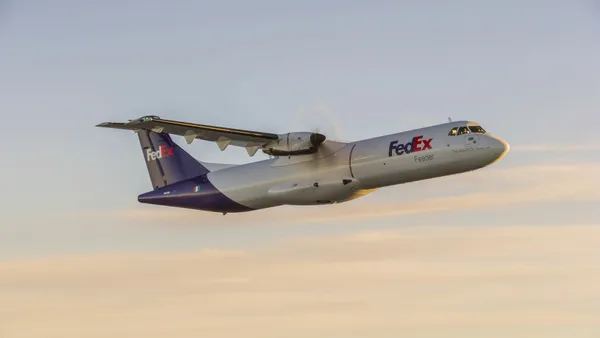Dive Brief:
- Global air cargo spot rates perked up 2% month over month in October to $2.28 per kilogram. That marked the first time since mid-May rates rose above seasonal levels in the first two weeks of the month, according to a November report from Xeneta’s Clive Data Services.
- Transpacific rates from China and Southeast Asia to the U.S. saw MoM increases of 10% and 15%, respectively, to $4 and $3.61 per kilogram. The jump in the latter corridor was due to a sharp MoM increase in chargeable weight.
- Spot prices from Europe to the U.S. also saw an uptick in October, up 7% MoM to $1.85 per kilogram because of expected declines in available capacity. This is due to space being influenced by seasonal passenger schedule adjustments, which started Oct. 29.
Dive Insight:
Spot rates declined at their slowest pace of 30% in October due to a slight increase in global cargo volumes and a reduction in available cargo space as passenger capacity slowed to pre-pandemic levels, Clive reported.
“October’s market performance is what we expected to see,” said Niall van de Wouw, chief airfreight officer at Xeneta. “It was a marginally busier month but not a cause for much optimism, nor pessimism. Carriers and forwarders are not expecting the market situation to improve significantly until well into the second half of 2024.”
Ongoing issues involving Ukraine and now the Israel and Gaza conflict add to these concerns, van de Wouw noted.
“This is a volatile market,” he said. “Freight forwarders are still procuring capacity on a short-term basis but are selling more long-term. That’s a risk, but clearly forwarders are not willing to commit to capacity because of so much uncertainty.”
There has been an increasing trend of shippers securing longer-term contracts, according to previous reports from Clive Data Services, but it becomes an issue when freight forwarders are selling long-term contracts but buying a majority of carrier volumes on the short term spot market, van de Wouw said in a 2024 outlook published this month.
In turn, this might prove to be a challenging situation in 2024 for freight forwarders, who are currently procuring roughly 50% of their capacity needs on a short-term basis when shippers want longer-term deals, according to the outlook.
Meanwhile, carriers are suffering from rising operating costs. Jet fuel costs continue to rise, with U.S. Gulf Coast jet fuel spot rates in the first three weeks of October rising 55% compared to the same month in 2019, according to Clive Data Services. Operating costs are also being impacted by inflation and labor shortages.














